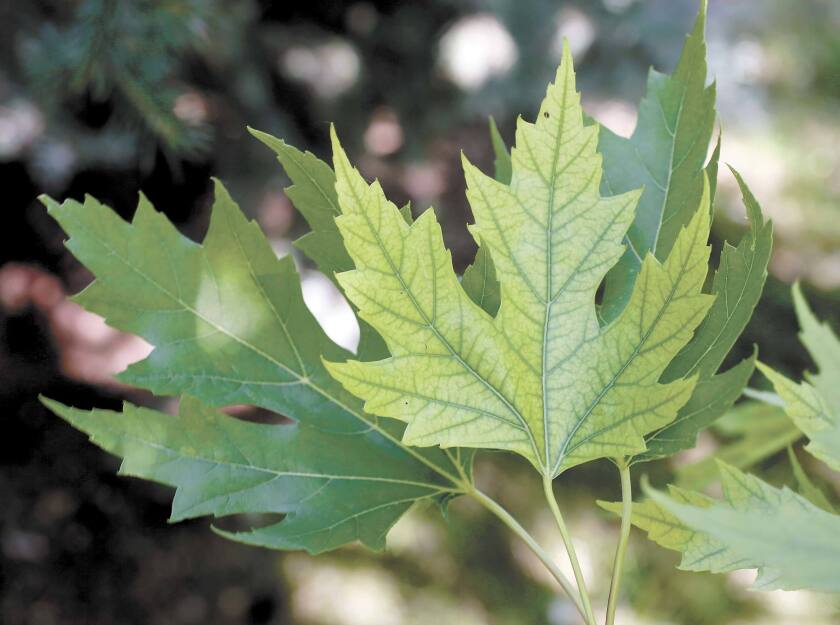FARGO — If you don’t count rabbit injury and tomato troubles, can you guess the next most common question I receive? It’s hands down why Autumn Blaze or other maple trees do poorly in some landscapes.
Everybody loves autumn foliage color, and maples are famous for their red, orange and copper shades. That’s why so many Autumn Blaze and other maples are planted.
Why do I get so many questions about maples? Problems arise because these tree types aren’t adapted everywhere, and where maples aren’t adapted, they quickly show their displeasure with sickly yellow leaves, cracks in the trunk and eventual branch dieback.
Winter hardiness isn’t the problem, as many of these maples thrive well in the cold of northern Minnesota. Instead, it’s mostly the soil.
Many of these maples are adapted to the naturally forested soils found east of the Red River Valley. In contrast, from the valley and points west, most soils are of prairie grassland origin, and some tree types, like Autumn Blaze maple, are less likely to thrive in prairie soils.
ADVERTISEMENT
Maples often respond to soil incompatibility with yellowing leaves in a disorder called chlorosis (pronounced "klor-OH-sis"). The leaf veins often remain green, and the areas between veins become lemon yellow, eventually including brown spots or crisp leaf margins. Without green chlorophyll, photosynthesis is reduced and the trees decline.

This soil incompatibility causes the tree’s roots to be unable to utilize nutrients in the soil, causing nutrient deficiencies, especially iron, giving the term iron chlorosis. Sometimes it’s magnesium or manganese that the roots are unable to utilize. Eventually branches may die, and if the deficiency occurs for several growing seasons, the entire tree can be weakened beyond recovery.
Although chlorosis is most commonly caused by iron deficiency, it doesn’t necessarily mean our soil lacks iron. The iron is often present, but in a form that the roots can’t access, made worse by heavy, compacted or poorly drained clay soil.
Another common factor that affects whether a soil is maple-friendly is the acidity or alkalinity of soil, which is termed pH. A pH of 7.0 is neutral, lower numbers are acid, and higher numbers are alkaline. North Dakota, South Dakota and western Minnesota have soils that tend to be alkaline. Forested regions of Minnesota begin the trend toward acid, which extends eastward in the United States.
Basic knowledge of soil pH can be a factor in chlorosis treatment. Iron tends to be more soluble if soil is slightly acid. In alkaline soils, iron begins to change into insoluble forms that some plant types, like maples, can’t absorb into their root systems.

One remedy for this situation is to avoid planting susceptible tree or shrub types. Silver maple is classically affected, along with Autumn Blaze and similar maples. Columnar poplar, crabapple, plum, pear and birch are more susceptible than trees like ash, bur oak and linden.
What are the treatments for iron chlorosis? If iron is more available in slightly acid soil, can we assist by adding acidifying products to our alkaline soil? Unfortunately, trying to change the pH of soil to accommodate a tree’s root system is like trying to change the color of the ocean by adding food coloring.
Instead, to treat iron deficiency chlorosis, we can apply iron products that are more easily accessed by plants, commonly called chelated iron (pronounced "KEY-lated"). Garden centers sell various forms. Some types are sprayed onto the foliage, and leaves will often green up within two weeks and the treatment might last from one to three months.
ADVERTISEMENT
Other forms are applied to the soil, and visible results might take several months, but soil applications last longer than foliar applications, usually a year. Iron can also be injected into the tree by inserting capsules into holes drilled in the trunk.
When applying any of the chelated iron products, it’s important to follow the label directions carefully to ensure success. Trees that have suffered with the ailment for years and are in a state of decline might not respond to treatment.
Before beginning treatment, a soil test will help identify soil pH and provide an analysis of iron and other nutrients. North Dakota State University and the University of Minnesota both have soil testing labs, which can be located by searching online.














